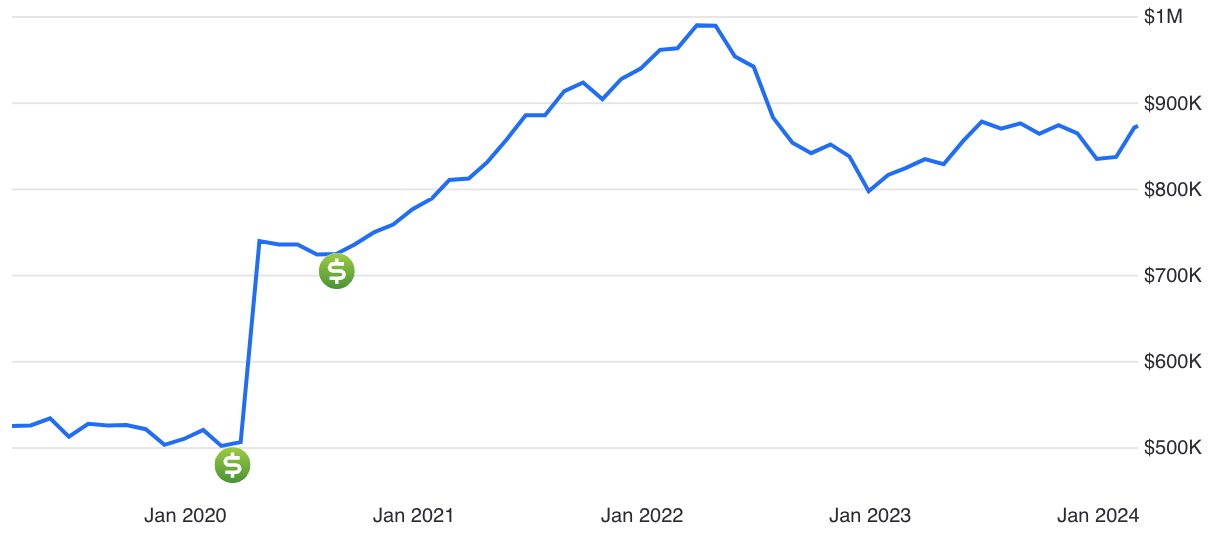How Accurate Are Zillow Zestimates?
Photo by Afif Ramdhasuma on Unsplash
Everyone loves online house shopping, and Zillow is one of the most popular sites to browse for real estate. It’s a great way to get high-level information and fantasize about places you’d like to live, or if you’re a homeowner, begin the process of considering whether to list your property and make the next move. However, before you take Zillow’s Zestimate as the gospel truth on the valuation of homes on the site, it’s important to take a moment to understand what the Zestimate is, and how accurate it may (or may not) be.
What is the Zillow Zestimate?
The Zestimate is an algorithmically generated estimate of a property's market value. Zillow introduced this feature to help users gain a rough understanding of a home's value without a professional appraisal. The Zestimate takes into account various factors to provide an estimated market value, and it is continuously updated based on new data.
Fundamentally, the Zestimate is calculated much the same way as we as Realtors make estimates of properties’ values by creating what’s called a Comparable Market Analysis (CMA). However, Zillow’s Zestimate is only an algorithm, and can only operate on publicly available information. It cannot know more nuanced information about a property, such as how it looks (or smells!), what improvements have been made, and so on. Most importantly, a Zestimate is NOT an appraisal. Appraisers are trained, unbiased professionals who do a much deeper dive into contextual information to derive as accurate an estimate of the property’s fair market value.
What the Zestimate really is, is a means to capture your attention on a given property, and get you to click to request a showing or contact an agent. These agents pay to play on the platform.
How is the Zestimate Calculated?
Zillow utilizes a sophisticated algorithm to calculate the Zestimate. The algorithm considers a wide array of factors, including but not limited to:
Property Details: Information about the property, such as the number of bedrooms, bathrooms, square footage, and other relevant features.
Comparable Sales: Zillow compares the target property with recent sales of similar homes in the area to gauge market trends and pricing.
Location: Proximity to amenities, schools, transportation, and neighborhood trends play a crucial role in determining a property's value.
Tax Assessments: Zillow incorporates tax assessments and other publicly available data to refine its estimate.
User-Submitted Data: Zillow allows users to update information about their homes, contributing to the accuracy of the algorithm.
It’s important to note that Zillow only scrapes data from publicly available sources. It is not a brokerage and is not a Multiple Listing Service (MLS). (Redfin on the other hand is a brokerage, and therefore has more integrated access to local MLS, potentially making their estimates more accurate.)
How Accurate is the Zestimate?
Zillow acknowledges that the Zestimate is an estimate, and it may not always reflect the precise market value of a property. The accuracy of Zestimates can vary depending on the local real estate market and the availability of recent and relevant data. According to Zillow's own data, they boast a “nationwide median error rate” for on-market homes of 2.4%. However, for off-market homes, the error rate is more than three times that rate, coming in at 7.49%.
Several factors can influence the accuracy of Zestimates:
Limited Data: In areas with sparse real estate activity, or where the local MLS does not participate in Zillow’s data collection, the lack of recent comparable sales data can impact the accuracy of the estimate.
Unique Features: Homes with unique characteristics or upgrades may not have comparable sales data, making it challenging to determine an accurate estimate.
Rapid Market Changes: In rapidly changing markets, Zestimates may struggle to keep up with the pace of price fluctuations.
Home Improvements: Zillow's algorithm might not fully account for recent renovations or upgrades, leading to discrepancies in the estimated value.
The more, and more recent, the data available for a property, the greater its accuracy is likely to be. In fact, you may notice that once a property goes on the market, the Zestimate promptly adjusts to very close to, if not exactly at, the listing price. Of course this makes sense; it’s the most recent data point, and presumes the property is listed at or near fair market value. Once the property closes, the final sale price sets the valuation once again. A good example is a historical look at the Zestimate of a property in Sacramento.
This was a property held by its original owners until it was listed in early 2020, and sold for $500,000. Over the next few months, the property was greatly improved, and put on the market in April 2020 for $739,000. You see how the Zestimate snaps to the new valuation; in the intervening months, Zillow’s algorithm had no way of knowing that improvements were being made. Had the owners made the improvements and simply kept the house, Zillow would not likely have greatly increased the valuation.
Conversely, an unimproved property in an area where many places are being renovated and sold is likely to be given an overly optimistic Zestimate, since to the algorithm it may look like properties in the area with comparable numbers of bedrooms, bathrooms, square footage, and so on, are suddenly experiencing drastic upticks in price.
Given all of this, you can see why the off-market accuracy rate of Zestimates is so much poorer than on-market ones.
While the Zillow Zestimate provides a convenient starting point for assessing property values, it's essential for users to recognize its limitations. Real estate transactions are complex, and the Zestimate is just one tool among many to help users make informed decisions. For a more accurate valuation, let us do the work and create a CMA for you.


